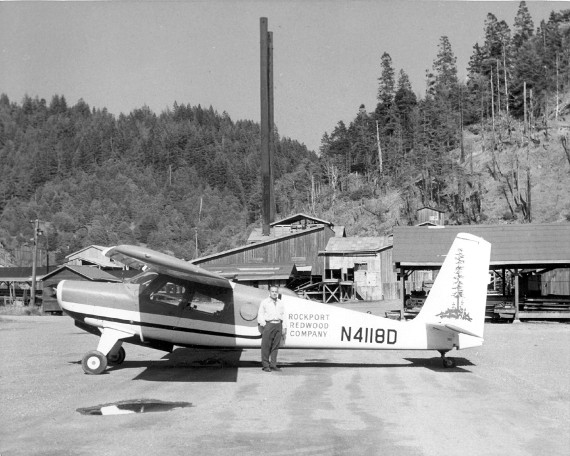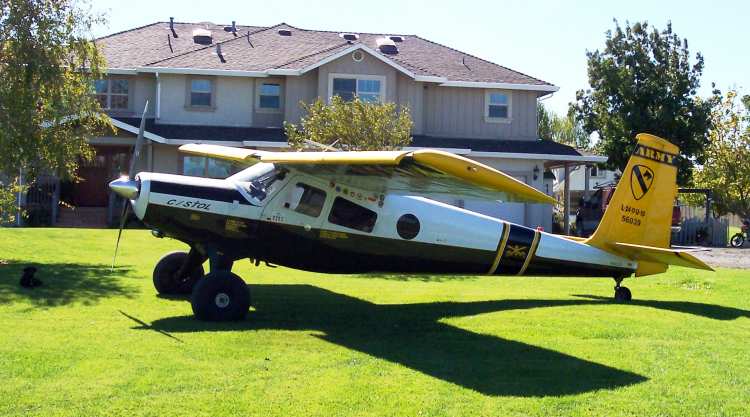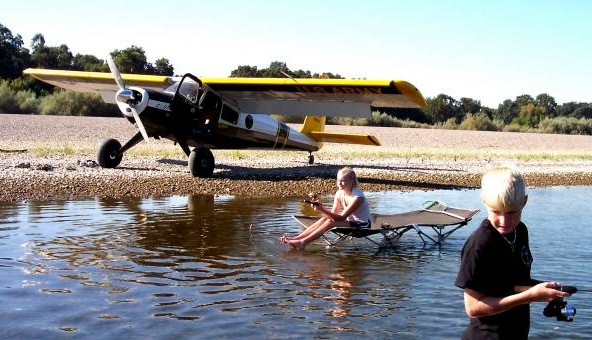|
In 1956 Rockport Redwood
Company purchased a Helio Courier, mainly for short
hops to Ukiah and San Francisco (Johnson, 14 June
2007). The flight from Rockport to Ukiah took 15 minutes
and from Ukiah to San Francisco 45 minutes (Rockport
Records, carton 3, folder 2-27). The company had been
using a female pilot, Meta Pool, who charged $30 an
hour to transport Rockport employees. "Meta Pool
talks a continuous stream from the moment you get
in the airplane until you get out," wrote Carl
Nelson, the company's self-taught CPA, in an inter-office
memo. "Anyhow she is a darn good pilot"
(ibid). Later the company would track, for six months,
the costs of owning the Helio Courier against hiring
Meta Pool to see if they were coming out ahead.
The Helio Aircraft
Company manufactured about 500 Helio Couriers in Pittsburg,
Kansas from 1954 until 1974. The light aircraft had
an outstanding capability for short take-off and landing
(STOL), able to execute a take-off or landing within
100 yards—about the length of one football field.
Only an aircraft with vertical take off and landing
(VTOL), like a helicopter, could beat that performance.
Fitted with floats or skis, the Helio could also land
on water. Its minimum control speed was 28 mph. All
this made the Helio ideal for bush pilots—and
for Rockport. The landing strip at
Rockport was in the center of the lumber yard. Like
the earlier lumber schooners, aircraft were also subject
to unpredictable weather at Rockport. An improvised
flag atop a poll gave a pilot landing at Rockport
a visual reference for wind direction and intensity.
In a letter of May 12, 1960, Bernie Agrons, the last
general manager at Rockport Redwood Company, mentions
the challenges of landing at Rockport:
We own a Helio
Courier which is a high performance aircraft
calpable of landing in 500-600 feet. While we
have approximately 1200 ft of runway, there
is a slight curve in the middle of the runway.
An airplane must make its approach over the
ocean and generally lands downwind. Once a landing
is attempted, the pilot is committed since if
he pulls up he will become involved in guy wires
and smoke stacks. (Rockport Records, carton
3, folder 3-12)
Both sons of Ralph
Rounds, Dwight and Bill, were private licensed pilots,
however, the Helio was Dwight's plane. Bill had a
two-engine plane that was "too big and hot to
 land
at Rockport" (Agrons email). Dwight appears below
in the photo of the Helio Courier with the Rockport
Redwood name on its side and a redwood illustration
on its tail. Dwight was around 30 years old at the
time. Tragically, about 15 years after this photo
was taken, Dwight died of a self-inflicted gunshot
wound on March 23, 1972 (Wichita Eagle-Beacon,
24 March, 1972, p. 1B). He had been president of Rounds
and Porter Wholesale Lumber. His namesake among his
six children became a Texas land developer and, somewhat
ironically, the author of The Year the Music Died:
1964-1972. The book, whose title evokes a refrain
from the 1972 hit American Pie, is a commentary
on the "golden age" of pop music from the
Beatles, John Lennon, the Rolling Stones, the Byrds,
the Doors, and other groups popular with the Baby
Boomers and beyond. land
at Rockport" (Agrons email). Dwight appears below
in the photo of the Helio Courier with the Rockport
Redwood name on its side and a redwood illustration
on its tail. Dwight was around 30 years old at the
time. Tragically, about 15 years after this photo
was taken, Dwight died of a self-inflicted gunshot
wound on March 23, 1972 (Wichita Eagle-Beacon,
24 March, 1972, p. 1B). He had been president of Rounds
and Porter Wholesale Lumber. His namesake among his
six children became a Texas land developer and, somewhat
ironically, the author of The Year the Music Died:
1964-1972. The book, whose title evokes a refrain
from the 1972 hit American Pie, is a commentary
on the "golden age" of pop music from the
Beatles, John Lennon, the Rolling Stones, the Byrds,
the Doors, and other groups popular with the Baby
Boomers and beyond.

Rockport Redwood Company
began looking for a buyer for the Helio Courier in
mid-1962. In a memo to Harry Merlo on May 23, 1962,
Carl Nelson says the airplane "has a value somewhere
in the vicinity of $10,000, although we have been
asking $15,000 for it" (Rockport Records, carton
3, folder 2-27).
Today Cliff Johnson
in Chico, CA is restoring the Rockport Helio Courier.
Attesting to the Helio's superb maneuverability, Cliff
says that, according to pilot folklore "if the
Helio had claws, it could land on a fence post."
At one point the Rockport plane was purchased by National
Geographic and used for photo flights in Peru. The
Rockport Helio also now has some special nose paint:
It now has some
original nose art painted by a famous WW2 Air
Force artist named Ira Latour. Ira is doing
a documentary on all his art and will be including
this plane in his movie...The nose art is Andy
Capp on one side and a Raven landing on a fence
post on the other. You may or may not know that
the Air America used the Helios a lot in Laos
in in the war that didn't exist. They were flown
by a group called the Ravens. (Johnson, 14 June
2007)
Johnson, who has been
a friend of Ira Latour's for many years, took him
the cowling off the Helio so that he could paint and
sign it (Johnson, 18 June 2007). Born in New York
in 1919, Latour grew up in Berkeley, CA and was a
student of Ansel Adams. During World War II, he was
the chief of aerial photography in the North African
and European theaters and also painted the noses of
combat airplanes. Today his photographs are in collections
of the New York Museum of Modern Art, the San Francisco
Museum of Modern Art, the Smithsonian National Museum,
and others.
As the pictures below
show, Cliff Johnson routinely lands the old Rockport
Helio on his lawn as well as on beaches and sandbars,
like the one pictured here on the Sacramento River.


Photo
Credits
Helio Courier
photo at Rockport Redwood Company mill by Bernard
Z. Agrons (Klamath Falls, OR).
Restored
Helio Courier photos by Cliff Johnson, Chico, CA.
Primary
Sources
Agrons,
Bernie, email to Doris M. Schoenhoff (MRC) on 14 June
2007.
Agrons,
Bernie. Video interviews at Rockport Beach and Rockport
Guest House, 6 May 2007, conducted by Doris M. Schoenhoff
(MRC).
Johnson,
Cliff, email to Doris M. Schoenhoff (MRC) on 14 June
2007 and 18 June 2007.
Rockport Redwood
Company Records, BANC MSS 70/184 c, The Bancroft Library
(Berkeley, California).
|
|